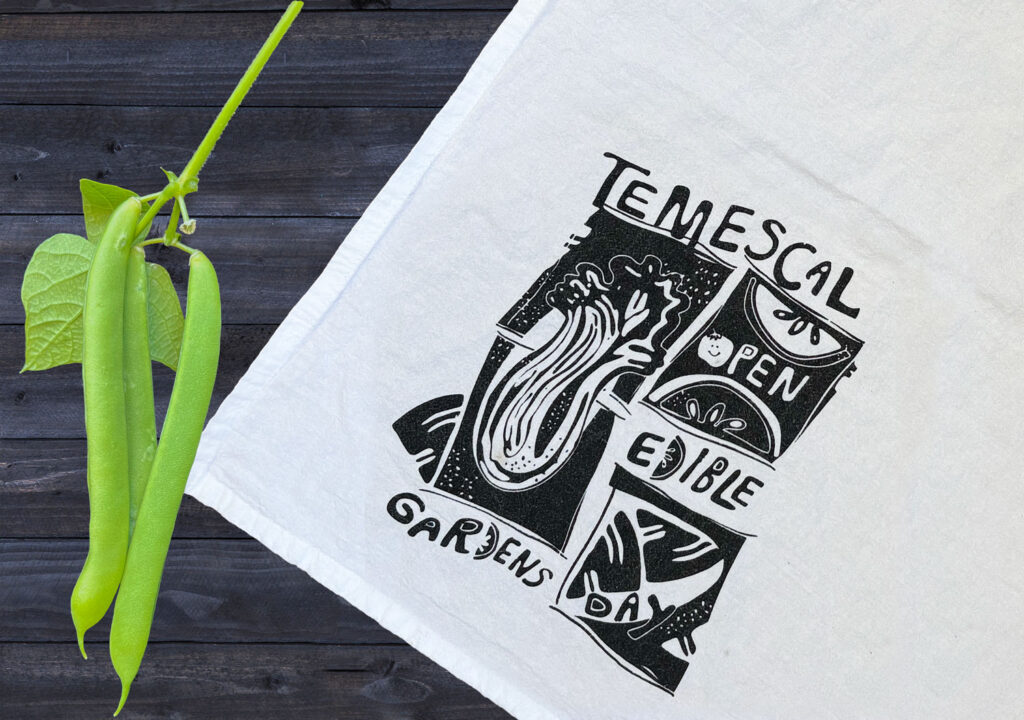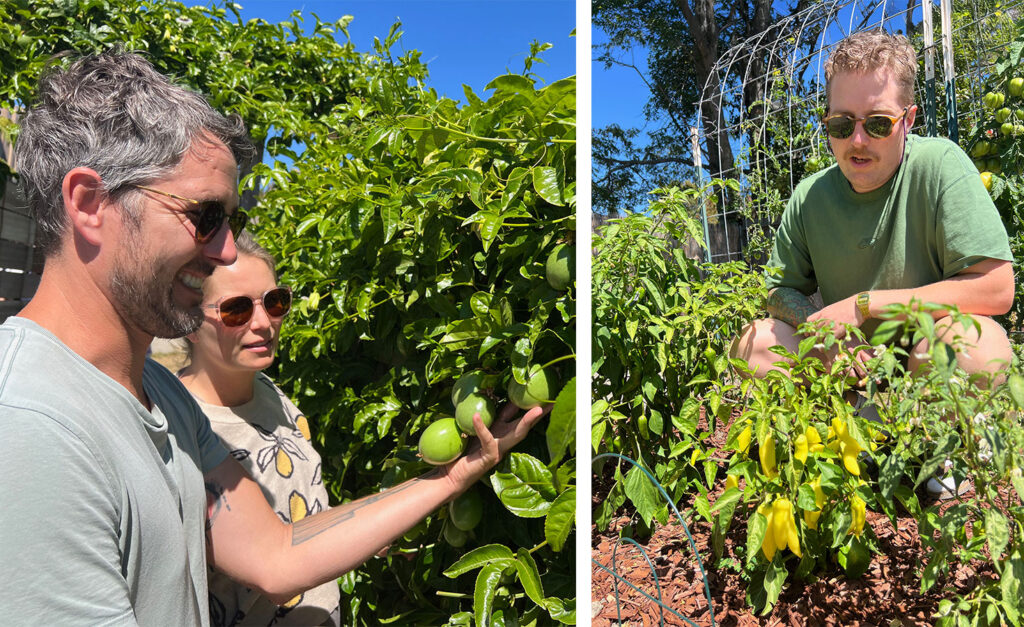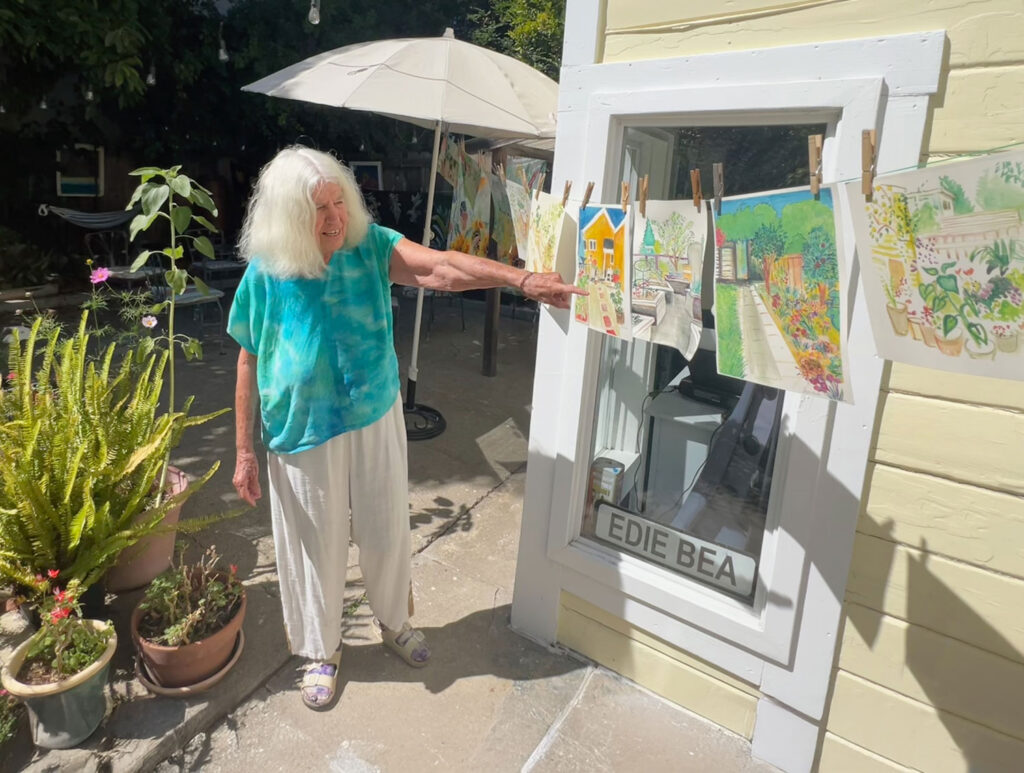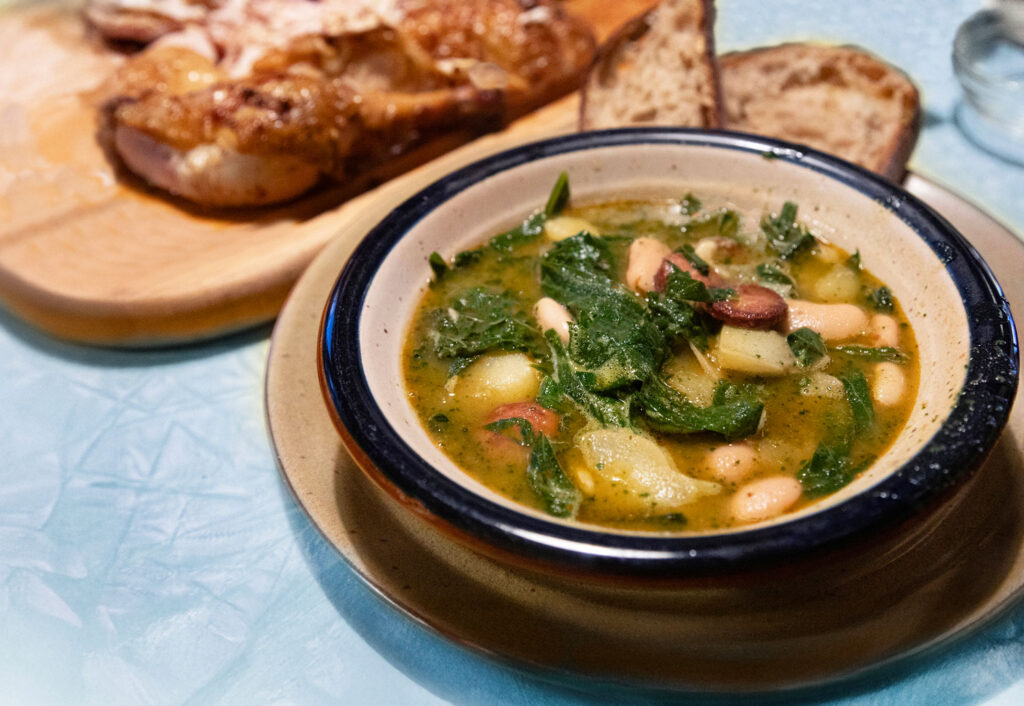Temescal Gardeners Open their Gates
By Rachel Trachten | Photos by Zach Pine

The Temescal Open Edible Gardens logo was created by artist Kathleen Miller. At the 2025 event, the logo was silk screened onto tea towels as gifts for volunteers.
Kelly Cannon moved to Oakland’s Temescal district from Brooklyn, New York, in 2021, and like many East Coast transplants, she was astonished to learn what home gardeners can grow here in our mild Mediterranean climate.
“As I walked with my dog, I’d see people growing figs, artichokes, or grapes in their front yards,” she says. Cannon and her partner, architect Jordan Pierce, had become enthusiastic farmers’ market shoppers in Brooklyn during the pandemic, and they were inspired to start their own garden. “When we moved here, we felt we could actually grow the things we’d been buying at the markets,” she says.

Temescal Open Edible Gardens organizer Kelly Cannon harvests romano beans in her home garden.
They found that neighbors’ gardens sparked conversations and new friendships, and this gave Cannon the idea for an open gardens event. She took an old-fashioned approach, leaving notes at doorsteps asking the residents if they might like to participate. Nine said “yes,” and Cannon put on her first annual Open Edible Gardens Day in 2023. The number of participants grew the following year, and volunteers joined Cannon to form a team of organizers.

Brothers Jim and Jeth Gold discuss the event map with Kelly Cannon.
By August 9, 2025, Open Edible Gardens Day had expanded to feature 21 gardens in a roughly ten-by-ten–block area, from 41st to 51st Streets and Telegraph Avenue to Broadway. Approximately 250 people showed up, coming from neighborhoods well beyond North Oakland. Cannon’s team directed foot traffic with a map, and colorful chalk signs on sidewalks pointed to participating gardens, half of which were open in the morning with the other half open in the afternoon. They set up a booth on 44th Street with Master Gardeners ready to answer questions. Along the streets and in the gardens, the happy buzz of neighbors getting acquainted or reacquainted filled the air.

Left: Ben Obriecht and Jenna Davenport shared cuttings from their passion fruit vines with visitors who came to their garden. Right: These banana peppers were among the 15 chili pepper varieties gardener Jonny Prestidge grew in 2025.
Peppers, Pets, and Pests
Many visitors sought gardening inspiration, but Veronika Fukson, who was lending her expertise at the Master Gardener booth, dealt with many questions about powdery mildew and pests. Cannon noted that pets were a problem too, describing how her own mischievous basset hound led her to plant vegetables in beds raised well out of the dog’s reach.
Jonny Prestidge had 15 varieties of chili peppers growing in his 50th Street garden. He planted them partly to repel rats and squirrels, but they also fed his culinary fascinations. On Open Edible Gardens Day, he was showing visitors his Buena Mulata peppers—which he said would ripen from a rich shade of purple to yellow, orange, and finally, red—and bright-yellow banana peppers that he was preparing to pickle. In an elegant British accent, he described his quest to replicate a hot sauce he had enjoyed on a breakfast sandwich at Newkirk’s Sandwich Shop in San Francisco. “I enjoyed the whole process, all the way from planting the seeds to harvesting, then the fermentation process, making the sauce, and bottling it. It takes nine months and feels like a long-term reward in a world of fast rewards.”
At Ben Obriecht and Jenna Davenport’s garden, visitors marveled over tall cacti and prolific cherry tomatoes. Obriecht said he had tired of their cats using his raised beds as a litter box, so he constructed a hydroponic system, seeking help from Reddit and other online forums. Visitors were especially curious about the passion fruit vines twining along their fences. “Halfway through I started trimming and handing out stems with nodes and explaining how I propagated it,” Davenport said. Obriecht added that they often mix passion fruit purée into their yogurt and that he’s known to make a mean passion fruit margarita.

Co-housing resident Jimmy Jessup introduced event organizer Kelly Cannon to the romano beans growing in the Temescal Commons garden.
Skill Shares and Seed Swaps
Cannon, whose career sits at the intersection of arts and technology, had invited artists to add their flair to the tour. Visitors delighted in colorful mosaics by elementary school teacher Josie Sommer and stunning batik flags made by Joanie Mitchell, who also displayed watercolor paintings she had made showing ten of the participating gardens. At a screen-printing booth on 45th Street, volunteers Kathleen Miller—who designed the event’s veggie-themed logo—and Angus Haller of Crosshatch Press were printing the logo onto tea towels that would be gifted to donors and volunteers. People who brought their own T-shirts and tote bags could get the logo printed on them as souvenirs of the joyous day.

Ben Obriecht’s handmade hydroponic system produced a bounty of tomatoes.
Visitors got a full dose of community spirit at Temescal Commons, a cohousing community on 42nd Street, where residents had set out some tasty romano beans for sampling. Member Jimmy Jessup told visitors how the compound’s ten households share responsibilities and enjoy their garden’s bounty together in dishes they make for a Sunday community meal.
Looking ahead, Cannon is already seeking sponsors for Open Edible Gardens Day 2026. She says that a local restaurant has expressed interest in using produce from participating gardens and donating a portion of its proceeds to the event. She is looking to extend the event throughout the year with small neighborhood skill-shares and seed swaps.

Joanie Mitchell’s watercolors depicted 10 of the gardens included in the event.
The wisdom of having each garden open for only half the hours of the event became evident as garden hosts Sue and Bruce Mark said they were looking forward to going out to see the other spots in the afternoon. Sue had spent the morning handing out chard, parsley, and collard seeds she had saved. Later she described the scene: “People were sitting around the table packaging seeds, and they start talking about their chickens and comparing what kinds of chickens they have. New neighbors said they just moved in and wanted ideas of what to plant. In the 30 years I’ve lived in the neighborhood and all the events we’ve taken part in, this feels like the most genuine way for people to get to know each other.” ♦
Writer Rachel Trachten and photographer Zach Pine picked up plenty of interesting ideas about growing veggies and getting to know neighbors while
visiting Temescal’s open edible gardens. Read Rachel’s stories at clippings.me/users/rachel_trachten and learn about Zach’s environmental art projects at zpcreatewithnature.com and sandglobes.org.

Photo by David Wajsfelner
Caldo Verde with Beans
David Wajsfelner and his partner, Amie Gutierrez, are members of the Temescal Open Edible Gardens Day planning committee, and they say that opening their home garden for the 2025 event motivated them to create a more beautiful and thriving space. “It was a fun, inspirational energy that ran through our gardening season this year,” says Gutierrez.
Wajsfelner imagines he could grow everything in this family heirloom recipe in his garden—except possibly the sausage. “It’s essentially the recipe brought by my grandmother, Maria, and mother, Aldina, when they emigrated from Portugal. They used to make it for us every fall and winter,” he says. “Think of it as a hearty hug and a replacement for a chicken soup if you’re feeling under the weather.”
Note on beans: Canned beans are fine when you’re in a hurry, Wajsfelner says. He’ll choose cannellini or another variety he has on hand like butter or great northern. When he has the time, he’ll soak ½ pound dry beans in salted water overnight and cook them the next day with salt, cumin, and garlic until they are tender but still firm.
Serves 6
- 1–4 tablespoons extra virgin olive oil, divided use
- 11 ounces spicy cured sausage (Portuguese linguiça or Spanish chorizo), cut into medallions
- 1 large sweet onion (yellow, white, or Vidalia), coarsely chopped
- 6–12 cloves garlic, coarsely chopped
- 2 pounds potatoes (Yukon Gold or russet), cut into ½-inch chunks
- Salt and pepper
- 5–8 cups chicken broth, divided use
- 1–2 bunches collards, kale, or other bitter leafy greens, cut into ¼-inch ribbons
- 1½–1¾ cups cooked cannellini beans (See note on beans above.)
Drizzle 1–2 tablespoons olive oil into the bottom of a Dutch oven and heat to medium. Add sausage and cook for approximately 6–8 minutes, stirring to brown on all sides. Remove sausage and set aside. Leave pot on heat (do not clean out) and add onion along with more olive oil as needed. Cook until onion is soft and starting to brown at the edges. Add garlic and cook another 1–2 minutes, stirring, until fragrant.
Add potato chunks and sprinkle with salt. Toss and cook briefly. Add 5–6 cups chicken broth and salt and pepper to taste. Bring to a boil, then reduce to a simmer, cover, and continue to cook for 10 minutes. Add the greens and simmer, covered, until potatoes and greens are tender, about 10 minutes. Add the canned or pre-cooked beans and the browned sausage along with more broth as needed. Simmer for another 5–10 minutes to heat through and blend flavors.
If you want to thicken the texture, use an immersion blender and blend to desired thickness. If you use a countertop blender or food processor, blend in small batches and handle the hot soup with care.
Serve with crusty bread and a vinegar hot sauce, which can really brighten up the dish. I like adding a bit of ume plum vinegar.

